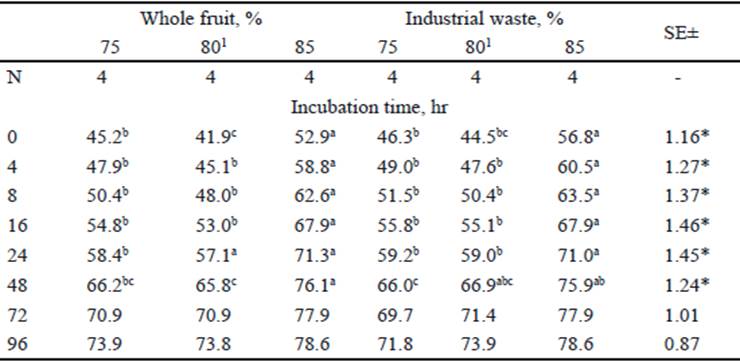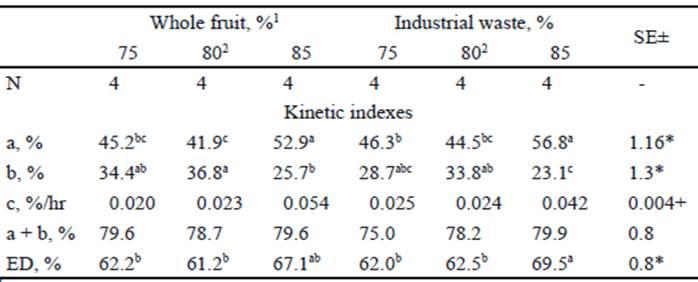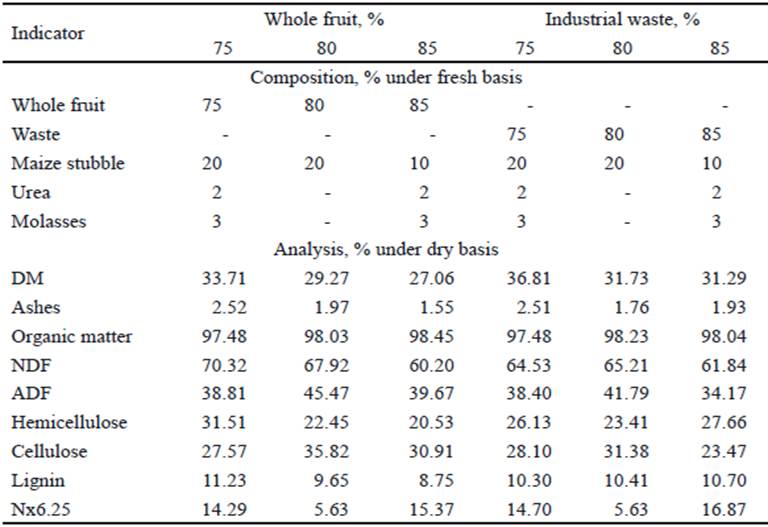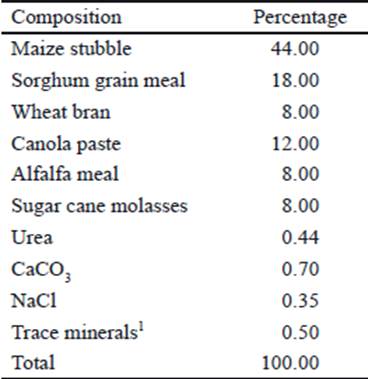INTRODUCTION
The use of harvesting and industrial tropical fruit wastes can help to avoid contamination to the environment when they are properly used (Gutiérrez et al. 2018). On the other hand, these wastes for ruminant feeding, offer the advantage of being a food resource of low cost and acceptable nutritional value (Pagan 2006 and Rego 2010).
To avoid the excessive influence of seasonality of fruits in the tropics, and therefore, having to handle large volumes in a relatively short period, it is possible to use silage technique, in the particular case of mango, there is evidence that it is possible to ensile fruits that are not suitable for consumption and industrial wastes (Pérez et al. 2009).
In the state of Nayarit during the harvest period from June to August 2005, an estimated production of 200,000 tons was presented (SAGARPA 2006). Previous studies indicate that there are crop losses by different nature ranging from 28 to 43 % (Ferrer 1987). Therefore, it is necessary to manipulate from 56,000 to 86,000 tons approximately, which are mainly concentrated in the industrialization plants.
Silage technique is an adequate alternative to preserve agroindustrial fruit waste, such as citrus wastes. In the case of mango wastes, there are records in Mexico (Aguilera et al. 1997), as well as recent research related to animal food (Filho et al. 2010 and Rego et al. 2010).
According to Ascanio et al. (2017), the technique of in situ ruminal digestion, offers the advantage of determining in a short time, with a reliable margin of security and at low costs, the nutritional value of different types of food submitted to the effect of the ruminal environment. With the use of this methodology, Conde et al. (2010) reported that ruminal degradability of Tommy Atkins mango peel and seeds was 99 and 54 %, respectively. The mixture of these wastes demonstrated a high ruminal degradability (Gonçalves et al. 2004), but it is intermediate for the values found by Conde et al. (2010).
The objective of this study was to evaluate the ruminal degradability of different silages based on agroindustrial and mango wastes with the addition of 2 levels of maize stubble, molasses and agricultural urea.
MATERIALS AND METHODS
This study was carried out in the facilities of the Unidad Académica de Agricultura, from Universidad Autónoma de Nayarit, Nayarit state, Mexico. Climate on this site is semi- warm or humid subtropical, according to Koppen classification. Rain regime is higher than 1,300 mm per year and the annual mean temperature varies from 20 to 29 ºC. The warmest months are between June and September, with a mean temperature of 23-24 ºC, while the coldest ones (16-17 ºC) correspond to December and January (García 1983). The altitude is 940 m.o.s.l.
In situ degradability of representative samples of six silage alternatives of mango wastes (Mangifera indica L. cv Tommy Atkins) was evaluated, mixed with maize stubble without grain of local origin. Composition of silage types is described in table 1. The materials to be evaluated came from microsilos made with two types of mango wastes, coming from harvest season, comprised between June and August 2009, Nayarit state, Mexico.
Ripe mango fruits were waste, which by appearance and consistency were not suitable for human consumption, and did not meet the requirements established by the companies for their industrialization. Mango wastes obtained from a processing plant was also used and was basically composed of peel and seed. Other additives used in addition to maize stubble were molasses from sugar cane and agricultural urea. Fruits and industrial wastes of mango constituted approximately 45, 55 and 60 % of the total silo under a dry basis, while, in that same order, stubbles were about 45, 45 and 30 % equally under dry basis. Agricultural urea and molasses contributed both with about 5 % of the silage dry matter.
For this research, 42-day conservation silages were used with a total of 24 samples (5 kg each) for each treatment. Table 2 shows the fermentative characteristics of these silages.
At the time of the evaluation, a subsample of 200 grams of each was extracted from the 24 samples. Once the subsamples were obtained, they were conveniently mixed, separated in three parts and dried in an oven at a temperature of 60 °C, for one week. After drying, they were ground with the help of a hammer mill equipped with a 2.5 mm screen. After samples were placed in plastic containers with lid for storage and subsequent use.
Four male Pelibuey x Dorper crossbred lambs were used, with a mean liveweight of 35 kg, which were previously implanted with a simple flexible polymer cannula in the rumen dorsal sac. They were previously internally and externally dewormed.
Table 2 Fermentative characteristics of silages of Nayarit mango wastes (under dry basis) with 42 days of conservation

Animals were housed in a group in a indoor stable, provided with appropriate feeders and drinking troughs. A diet with similar ingredients to the tested treatments was used (table 3).
Food was offered daily at 10:00 am at a rate of 1 kg/animal per day (fresh basis), while water was available at all times. At the beginning of this experimental phase, animals were adapted to the diet for a period of 15 days.
In situ procedure of ruminal degradability, proposed by Mehrez and Orskov (1977), was used. Three grams for each standard nylon bag, measuring 5 x 10 cm and with a porosity of 50 μm/cm2 were weighed and three repetitions per each sample and each hour were used. Later, they were closed by means of rubber bands and fastened with a special tie to metal rings. Bags were hanged in key holders, so that they were attached to a rope that was cast through the cannula into the rumen of animals to allow handling. Finally, those 24 bags with the samples were subjected to ruminal incubation in each of the four animals at 0, 4, 8, 16, 24, 48, 72 and 96 hours, with a total of 96 bags and samples from the four animals used. Incubation process started at 12:00 p.m. and successive extractions were made at random according to the programmed times of permanence in the rumen of each treatment, to finally remove all the bags at the end of the 96-hour incubation time.
After having removed the bags, they were washed three times with water in a commercial washing machine with a capacity of 4 kg, in order to make them as clean as possible. Each wash cycle lasted 5 minutes. Bags belonging to 0 time, occupied by the controls were washed separately to avoid their influence on the gain or loss of weight at the end of the process. Finally, they were placed on aluminum trays and placed in a forced air oven at a temperature of 55 °C during 24 hours for drying.
Dry matter (DM) content of samples was determined by gravimetry by drying in an oven with forced air circulation, according to A.O.A.C (1990). All determinations were made in duplicate.
Kinetics of in situ disappearance of DM in the incubated samples was described by the following equation, proposed by Orskov and McDonald (1979) and McDonald (1981).
Where "y" is DM disappearance in the time t, "a" is the immediately degradable fraction, "b" corresponds to the potentially degradable fraction by fermentation, while "a + b" is the total of "y", which can be degraded and "c" is the rate of degradation of fraction "b" (Mehrez and Orskov 1977, Orskov and McDonald 1979 and McDonald 1981). On the other hand, the effective degradability (ED) was calculated according to Orskov and McDonald (1979), taking into account the speed or step rate of ruminal digesta, k, in the following equation:
In this study, the value of k was assumed as 5 %/ hour, corresponding to a moderate productive level (ARC 1984).
In previous analyzes, there was no significant effect (P <0.05) of animal or animal x silage type interaction. Consequently, means for each incubation time, as well as in situ degradation kinetics indices were contrasted by the analysis of variance technique according to a single effect design (Steel et al. 1997), and in the cases where significant differences were found (P <0.05), means were compared by Tukey multiple comparison test. A general linear model was used for data manipulation, using the statistical package SAS (2003), for computers. The linear model applied was the following:
RESULTS
Table 4 shows the results of the test, from the point of comparison of treatments within each in situ ruminal incubation time. A significant effect (P <0.05) of treatment was found between 0 and 48 hours for DM degradation, with higher values for treatments with a higher content of whole fruit or industrial wastes (85 %). In contrast, all treatments did not seem to show a different percent degradation when they were incubated for 71 and 96 hours, and showed an average value of 73.1 and 75.1 %, respectively. Table 5 lists data corresponding to indexes of in situ ruminal degradation kinetics of different evaluated silages. Significant statistical differences were found (P <0.05) among silage types for the immediately degradable (a) and potentially degradable (b) fractions, but neither (P <0.10) for degradation kinetic constant (c) nor for degradation potential (a + b). The effective degradability (ED) was significantly (P<0.05) higher in silages with a high content of ensiled mango wastes with respect to the other four types of materials, a trend that was similar for the constant "c" in these two types of silages.
Table 4 Influence of incubation time on in situ ruminal degradation of DM in silages of Nayarit mango wastes (in percentages)

1 Do not contain urea and sugar cane molasses. For more details, see table 1. *P<0.05
abc Means without common letter in the same line differ significantly (P<0.05) among them
Table 5 Kinetics of in situ ruminal degradation of DM in silages of Nayarit mango wastes

1 Percentage of fresh basis inclusion
2 Do not contain urea and sugar cane molasses. For more details, see table 1 + P<0.10; * P<0.05
abc Means without common letter in the same line differ significantly (P<0.05) among them
DISCUSSION
Although there is plenty of studies referring to in situ ruminal degradation of different food resources, there are only a few concerning different mango silage products. In studies, similar to those used in this research, Aguilera et al. (1997) found that DM disappearance in the incubated samples, after 45 days of preservation, was 54.0-54.5%. In vitro degradation of DM, measured in the same silage types, was 59.1 and 60.5%, respectively. Such data are considerably lower than those reported in this article. Other studies of in vitro degradability of mango peel, ensiled or not, have indicated high values of DM disappearance at 48 hours of incubation, 75.9 and 79.8 %, respectively, compared with seeds of the same fruit, 45.1 % (Sruamsiri and Silman 2009). The above indicates that mango fruit has a high degradation because it contains a large number of rapidly degradable compounds, contrary to what happened with the maize stubble fiber. It is also known that the addition of N as a non-protein source has repercussions in dry matter digestibility (Sánchez-Duarte and García 2017). In a research carried out on alfalfa varieties at different harvesting days and consequently on plant maturity, they found that the older the cut, the lower the DM degradation (Boschini-Figueroa and Chacón-Hernández 2017). In another study with agricultural by-products such as henequen bagasse, Gutiérrez et al. (2018) found greater degradability than 63 % at 72 h of in situ incubation.
In vitro degradability of DM silage of Penisetum purpureum with levels up to 15% of mango byproducts did not show substantial changes in the experiment conducted by Porras (1989). Meanwhile, Ledea et al. (2016) evaluated ruminal fermentation of Cenchrus purpureus in different plant fractions such as leaves and stems at different ages. In both parts, 50 % of degradation was surpassed. This percentage reached the maximum potential at 72 h, but decreased for fractions that were more than 120 days old. This situation could be similar to what happened in this research where high content of mango in its different presentations could influence the degradation of maize stubble, by providing a higher amount of rapidly degradable material for ruminal microorganisms, which coincides with the aforementioned by Villa et al. (2010). On the other hand, González et al. (2015) conducted the evaluation of the ruminal degradability of food by-products in fistulated sheep, where they concluded that physical and chemical characteristics of each ingredient have a direct influence on their degradation rate in the rumen.
In Tommy Atkins mangos, Conde et al. (2010) indicated values of degradability for peel and seed ascending to 99 and 54 %, respectively. Similarly, Pereira et al. (2008) reported that in vitro ruminal disappearance of DM in the case of mango wastes, essentially pulp, was very high, 83-84 % between 48 and 96 hours. This suggests that the values of degradability will necessarily be intermediate in mixtures where mango peel and seeds predominate, due to the low degradability of the fiber fraction of seeds, rich in ADF in comparison with the peel (Pereira et al. 2008).
It is likely that, in the study by Aguilera et al. (1997), the evaluated silages were very rich in fiber, thus making in vitro and in situ ruminal degradability low. Perhaps the quality of maize stubble to be mixed with mango wastes could be another factor that may reflect changes in the digestive use of nutrients in the resulting mixtures. In this study, silages with more mango wastes and a lower proportion of maize stubble appeared to show higher figures of in situ ruminal degradation, at least until 48 hours of measurement. On the other hand, Valles et al. (2016) conducted an evaluation of different tropical grasses at different cut ages, which confirmed that cut age is related to degradation, because as the older the plant is the lower degradation due to the amount of lignin in the forage. This was manifested in the present study because stubble contents showed lower values of degradability in the times evaluated.
In this study, treatments containing urea and a lower maize stubble content seemed to determine higher values for the in situ ruminal degradability of DM. In this respect, Sruamsiri and Silman (2009), indicated that, when they supplied mango silage to cows, rectal DM digestibility increased from 53.8 to 58.6% when including between 0 and 15 % of leucaena leaves in the ration. Likewise, Sánchez and García (2017) evaluated N concentration in a silage used in dairy cattle and observed that N concentration in the ration influences digestibility, intake and milk production.
Data related to kinetics of in situ ruminal degradation suggest that silages with the highest proportion of mango products, whether fruit or industrial waste, showed a faster degradation of DM (c) and showed values within the range suggested by Sampaio (1988), for the degradation rate of good quality plant foods (from 2 to 6 % per hour). In the same way, it happened with the instant disappearance (a), in consonance with suggestions of Orskov and McDonald (1979). This instantaneous disappearance, 41.9-56.8 %, was considerably lower than that reported with other forage resources, such as Cenchrus purpureus, which presented the highest values of degradability at a cut age between 80 and 100 days (Ledea-Rodríguez et al. 2018).
When variable levels of mango wastes were added to elephant grass silages, Rego et al. (2008) noted that potential (a + b) and effective in situ disappearance in the rumen of sheep increased with the inclusion of ensiled mango wastes, which is in agreement with the results of the present experiment. In the case of industrial by-product of mango without being ensiled, Gonçalves et al. (2004) observed an effective DM degradation that rose 61.1 %, with a step rate of 5 %/hour, in their in situ digestion studies. This rather high figure also corroborates the high in situ digestive use, found in the research reported here.
CONCLUSIONS
It is concluded that treatments with a higher content of whole fruit or industrial mango waste presented the highest ruminal degradation, probably influenced by its high content of rapidly fermentable material. It is suggested to perform tests to evaluate performance traits in ruminants fed with silages of mango wastes, as well as performing studies of in vivo digestion or in vitro gas production.











 text in
text in 




